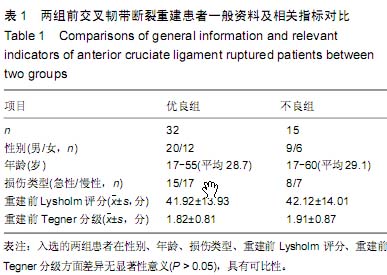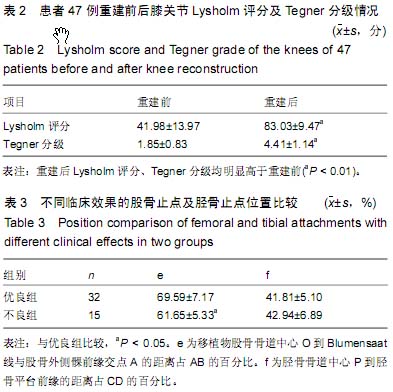| [1] Tashman S, Araki D. Effects of anterior cruciate ligament reconstruction on in vivo, dynamic knee function. Clin Sports Med. 2013;32(1):47-59.
[2] Bull AM, Earnshaw PH, Smith A, et al. Intraoperative measurement of knee kinematics in reconstruction of the anterior cruciate ligament. J Bone Joint Surg Br. 2002;84(7): 1075-1081.
[3] Siegel L, Vandenakker-Albanese C, Siegel D. Anterior cruciate ligament injuries: anatomy, physiology, biomechanics, and management. Clin J Sport Med. 2012;22(4):349-355
[4] 罗浩,敖英芳,王海军,等.膝关节前交叉韧带前内束和后外束股骨止点位置的解剖研究[J].中华关节外科杂志(电子版),2012;6(1): 97-103.
[5] 李丁峰,皇甫小桥,赵金忠.腓骨长肌腱前半部作为自体移植材料的临床研究[J].中华骨科杂志,2014,34(3):285-292.
[6] 王成伟,刘利兵,贾卫东,等.磁共振成像评价膝关节半月板损伤:与关节镜检查的对照分析[J].中国组织工程研究,2014,18(46): 7406-7411.
[7] Ghodadra N, Mall NA, Karas V, et al. Articular and meniscal pathology associated with primary anterior cruciate ligament reconstruction. J Knee Surg. 2013;26(3):185-193.
[8] 范宏斌,张春礼,李明全,等.前交叉韧带断裂后半月板和软骨损伤的临床研究[J].中华创伤杂志,2004,20(2):73-76.
[9] Frank RM, McGill KC, Cole BJ, et al. An institution-specific analysis of ACL reconstruction failure. J Knee Surg. 2012; 25(2): 143-149.
[10] Bourke HE, Gordon DJ, Salmon LJ, et al. The outcome at 15 years of endoscopic anterior cruciate ligament reconstruction using hamstring tendon autograft for 'isolated' anterior cruciate ligament rupture. J Bone Joint Surg Br. 2012;94(5): 630-637.
[11] Davies H, Tietjens B, Van Sterkenburg M, et al. Anterior cruciate ligament injuries in snowboarders: a quadriceps- induced injury. Knee Surg Sports Traumatol Arthrosc. 2009; 17(9):1048-1051.
[12] Prodromos CC, Han Y, Rogowski J, et al. A meta-analysis of the incidence of anterior cruciate ligament tears as a function of gender, sport, and a knee injury-reduction regimen. Arthroscopy. 2007;23(12):1320-1325.
[13] Forsythe B, Kopf S, Wong AK, et al. The location of femoral and tibial tunnels in anatomic double-bundle anterior cruciate ligament reconstruction analyzed by three-dimensional computed tomography models. J Bone Joint Surg Am. 2010; 92(6):1418-1426.
[14] Brown CH Jr, Spalding T, Robb C. Medial portal technique for single-bundle anatomical anterior cruciate ligament (ACL) reconstruction. Int Orthop. 2013;37(2):253-269.
[15] Meuffels DE, Reijman M, Verhaar JA. Computer-assisted surgery is not more accurate or precise than conventional arthroscopic ACL reconstruction: a prospective randomized clinical trial. J Bone Joint Surg Am. 2012;94(17):1538-1545.
[16] Iriuchishima T, Shirakura K, Yorifuji H, et al. Size comparison of ACL footprint and reconstructed auto graft. Knee Surg Sports Traumatol Arthrosc. 2013;21(4):797-803.
[17] 周肇庸,费起礼.现代关节镜外科学[M].天津:天津科学技术出版社,2005.
[18] Bernard M, Hertel P, Hornung H, et al. Femoral insertion of the ACL. Radiographic quadrant method. Am J Knee Surg. 1997;10(1):14-21.
[19] Klos TV, Habets RJ, Banks AZ, et al. Computer assistance in arthroscopic anterior cruciate ligament reconstruction. Clin Orthop Relat Res. 1998;(354):65-69.
[20] Cameron JC, Saha S. Meniscal allograft transplantation for unicompartmental arthritis of the knee. Clin Orthop Relat Res. 1997;(337):164-171.
[21] Wolf BR, Ramme AJ, Wright RW, et al. Variability in ACL tunnel placement: observational clinical study of surgeon ACL tunnel variability. Am J Sports Med. 2013;41(6):1265-1273.
[22] McConkey MO, Amendola A, Ramme AJ, et al. Arthroscopic agreement among surgeons on anterior cruciate ligament tunnel placement. Am J Sports Med. 2012;40(12):2737-2746.
[23] Sullivan JP, Matava MJ, Flanigan DC, et al. Reliability of tunnel measurements and the quadrant method using fluoroscopic radiographs after anterior cruciate ligament reconstruction. Am J Sports Med. 2012;40(10):2236-2241.
[24] Odensten M, Gillquist J. Functional anatomy of the anterior cruciate ligament and a rationale for reconstruction. J Bone Joint Surg Am. 1985;67(2):257-262.
[25] Odensten M, Gillquist J. A modified technique for anterior cruciate ligament (ACL) surgery using a new drill guide for isometric positioning of the ACL. Clin Orthop Relat Res. 1986; (213):154-158.
[26] Zantop T, Petensen W, Fu F. Anatomy of the anterior cruciate ligament. Oper Tech Orthop. 2005;15(1):20-28.
[27] Zavras TD, Race A, Bull AM, et al. A comparative study of 'isometric' points for anterior cruciate ligament graft attachment. Knee Surg Sports Traumatol Arthrosc. 2001;9(1): 28-33.
[28] 徐卿荣,朱振安.前交叉韧带胫、股骨重建位置变化对等距特性的影响[J].中华创伤杂志,2005,21(2):131-133.
[29] Khalfayan EE, Sharkey PF, Alexander AH, et al. The relationship between tunnel placement and clinical results after anterior cruciate ligament reconstruction. Am J Sports Med. 1996;24(3):335-341.
[30] Behrend H, Stutz G, Kessler MA, et al. Tunnel placement in anterior cruciate ligament (ACL) reconstruction: quality control in a teaching hospital. Knee Surg Sports Traumatol Arthrosc. 2006;14(11):1159-1165.
[31] Howell SM, Clark JA. Tibial tunnel placement in anterior cruciate ligament reconstructions and graft impingement. Clin Orthop Relat Res. 1992;(283):187-195.
[32] 郭林,杨柳,王爱民,等.前交叉韧带起止点X射线下定位的研究[J].中华创伤杂志,2006,22(6):443-446. |


.jpg)